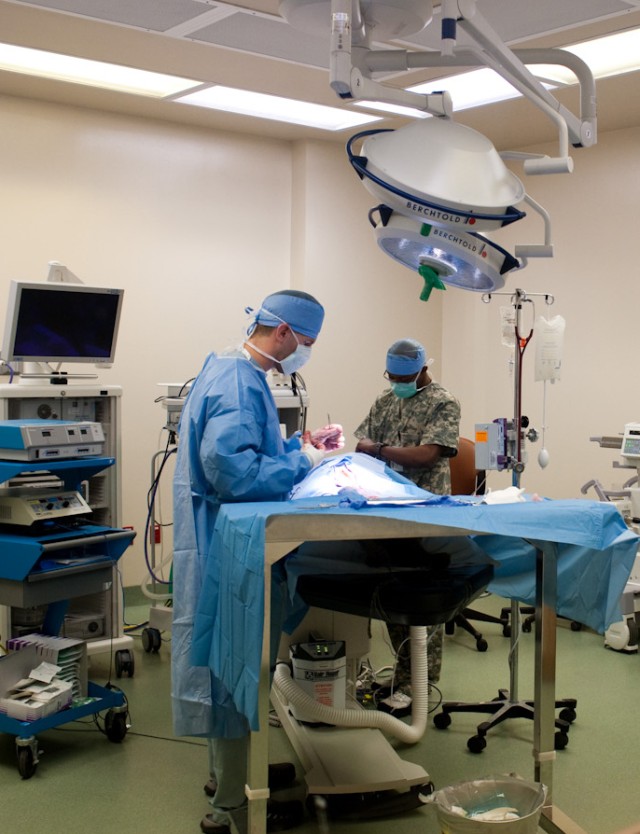The melding of veterinary and preventive medicine missions into the U.S. Army Public Health Command will bring many common and connected activities and responsibilities.
For instance, veterinary food inspection Soldiers (MOS 68R) and officers (AOC 64) have worked closely with preventive medicine specialists (MOS 68S) and environmental science officers (AOC 72D) for years in troop dining facilities, post exchange food courts, shoppettes, "roach coaches" and the like. Both work toward the same goal of ensuring food hygiene and safety for Soldiers and retirees, their family members and civilian employees.
However, one thing that will make the USAPHC a "public health plus" organization is animal care. There are some preventive medicine/public health aspects to animal care, just like there are for "people care," vaccinations for instance.
However, performing surgery to reconstruct the skull of an explosives-sniffing dog assaulted in Afghanistan is not something familiar in preventive medicine circles.
The Army Veterinary Corps provides animal care to all branches of service. Corps members are located on Navy, Marine Corps and Air Force bases as well as Army installations. Other services may have veterinarians, but they serve in bioenvironmental and preventive medicine/public health roles, not animal care.
The Army takes care of all DoD-owned animals, including military working dogs (MWDs), horses and mules (mostly ceremonial, but also serving as pack animals at a Marine Corps mountain warfare school), marine mammals with the Navy, laboratory animals, some non-DoD government animals.
The Army also looks after animals that work with Secret Service, Customs, Border Patrol and Transportation Security Administration, and also pets of servicemembers and retirees, their families, and even some civilian employees (those authorized health care in DOD medical facilities).
The primary focus of veterinary care in the DoD is military working dogs. There are approximately 2,000 dogs in all branches plus another 800 to 900 at the DoD Military Working Dog School, Lackland Air Force Base, Texas. These dogs are trained to detect explosives or drugs and are usually also dually trained as "patrol" dogs, which means they alert, deter and potentially attack. They also defend their handlers.
For the intervening period between the Vietnam era and current overseas contingency operations, MWDs performed almost exclusively in the area of law enforcement, checking for drugs in barracks, cars or other locations, and securing installations on patrols. However since 2001, both the number and uses of these dogs have increased dramatically. There were approximately 1,500 to 1,600 dogs in the 2000 inventory.
Dogs are also now used in combat operations with infantry, ranger/special operations, and engineers (mine detection), as well as for law enforcement. Additionally, dogs are used to track humans and find individual explosive devices. One engineer unit has a pilot program for urban search-and-rescue dogs.
Dogs also are being used for mental health therapy in deployed environments. Small programs such as these could eventually lead to even more diverse roles for dogs in DoD.
Veterinary care for these four-footed servicemembers closely parallels that for their bipedal counterparts. Each dog is medically screened prior to procurement and receives periodic health assessments semiannually and dental prophylaxis annually once they graduate from dog boot camp at Lackland.
MWDs receive routine preventive medical care and attention for most ailments at their local duty station veterinary treatment facility. Dogs that require more advanced diagnostics, surgery or medical care not available locally are generally referred to one of three DoD facilities, or in some cases, more local civilian veterinary colleges or specialty practices.
DoD facilities at Kadena Airbase, Okinawa, Japan; Pulaski Barracks, Vogelweh, Germany; and the Holland MWD Hospital at Lackland have more advanced equipment and specialty-trained personnel to handle more difficult cases. Examples include neurosurgery, orthopedic surgery, endoscopy, rehabilitation/physical therapy and dentistry.
Veterinary Corps officers are also in deployed locations supporting the hundreds of working dogs supporting all overseas contingencies.
Once USAPHC (Prov) reaches full operational capability in October of 2011, it will be responsible for providing MWD and pet care throughout the Pacific, Europe and the continental U.S. Many current USAPHC (Prov) members who have not had experience with animal care operations and all that goes with it will soon find themselves as part of a great team that will help to conserve the "biting" strength.
Related Links:
Explosive-detection dog teams enhance Iraq's security checkpoints






Social Sharing